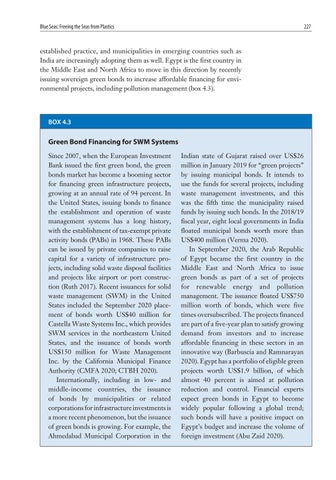Blue Seas: Freeing the Seas from Plastics
227
established practice, and municipalities in emerging countries such as India are increasingly adopting them as well. Egypt is the first country in the Middle East and North Africa to move in this direction by recently issuing sovereign green bonds to increase affordable financing for environmental projects, including pollution management (box 4.3).
BOX 4.3
Green Bond Financing for SWM Systems Since 2007, when the European Investment Bank issued the first green bond, the green bonds market has become a booming sector for financing green infrastructure projects, growing at an annual rate of 94 percent. In the United States, issuing bonds to finance the establishment and operation of waste management systems has a long history, with the establishment of tax-exempt private activity bonds (PABs) in 1968. These PABs can be issued by private companies to raise capital for a variety of infrastructure projects, including solid waste disposal facilities and projects like airport or port construction (Ruth 2017). Recent issuances for solid waste management (SWM) in the United States included the September 2020 placement of bonds worth US$40 million for Castella Waste Systems Inc., which provides SWM services in the northeastern United States, and the issuance of bonds worth US$150 million for Waste Management Inc. by the California Municipal Finance Authority (CMFA 2020; CTBH 2020). Internationally, including in low- and middle-income countries, the issuance of bonds by municipalities or related corporations for infrastructure investments is a more recent phenomenon, but the issuance of green bonds is growing. For example, the Ahmedabad Municipal Corporation in the
Indian state of Gujarat raised over US$26 million in January 2019 for “green projects” by issuing municipal bonds. It intends to use the funds for several projects, including waste management investments, and this was the fifth time the municipality raised funds by issuing such bonds. In the 2018/19 fiscal year, eight local governments in India floated municipal bonds worth more than US$400 million (Verma 2020). In September 2020, the Arab Republic of Egypt became the first country in the Middle East and North Africa to issue green bonds as part of a set of projects for renewable energy and pollution management. The issuance floated US$750 million worth of bonds, which were five times oversubscribed. The projects financed are part of a five-year plan to satisfy growing demand from investors and to increase affordable financing in these sectors in an innovative way (Barbuscia and Ramnarayan 2020). Egypt has a portfolio of eligible green projects worth US$1.9 billion, of which almost 40 percent is aimed at pollution reduction and control. Financial experts expect green bonds in Egypt to become widely popular following a global trend; such bonds will have a positive impact on Egypt’s budget and increase the volume of foreign investment (Abu Zaid 2020).






